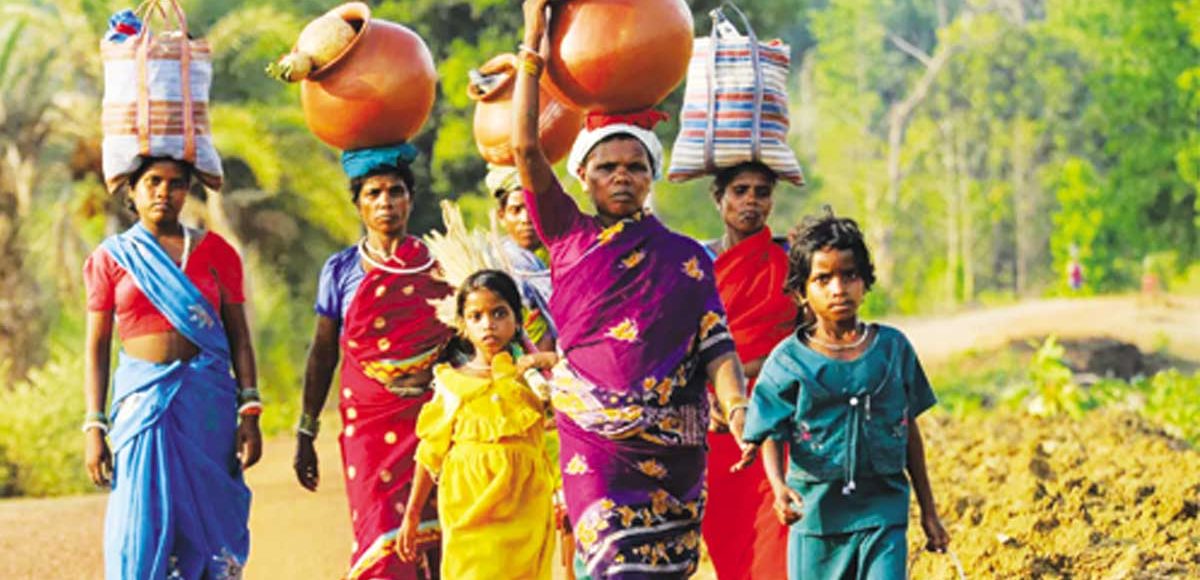Prof. Vipul J Somani, Mahatma Gandhi Department of Rural Studies, Veer Narmad South Gujarat Univevrsity, Surat
Migration of poor from rural areas to the urban and semi-urban parts of the district and states is a common phenomenon. A lot of work has been and is being carried out by State and Central governments in the form of providing infrastructure and works in the rural areas of Gujarat and entire country. Despite such efforts migration continues. The migrants include farmers and farm labours both. The farmers are land owner and cultivate their land during monsoon only. The farm labours work in the fields of farmers during monsoon and for rest of the time they search jobs. Successful implementation of Mahatma Gandhi National Rural Employment Guarantee Act failed to prevent migration in many parts of the country. This paper deals with the causes of migration in the tribal villages of South Gujarat and discusses the strategies for its prevention on a permanent basis.
Migration is a painful phenomenon for the family especially when it is made in distress. Usually the young male members of the family migrate to the nearby villages or towns in search of work to earn their livelihood. Sometimes the young couples with children go out in search of work leaving their parents, cattle and land behind. The ones that are left at home struggle for their survival in absence of the care takers. The migrants also suffer a lot when they go to work in nearby or fara way places. The suffering starts from place to live, search for job and uncertainty of availability of jobs. If the migrants have brought family members including wife and child/children the suffering is more. Many a time they live in below human dignity conditions. The migrants include both farmers and farm labours. It is said that agriculture is the backbone of Indian economy and a vast majority of population lives in villages that are dependent directly or indirectly on agriculture. However, in recent years the share of agriculture in the economy has been reducing and so is the population dependent on it. In India more than half of the cultivable land is rain fed and the farmers are solely dependent on rain for their yield. The 48.8 % of land that is under irrigation also is incapable of year round cultivation. Most of the land under irrigation has underground water sources that are dependent on rainfall for its recharge. Such land can be tilled for cultivating two crops instead of year round agricultural practices.
In the hilly and undulating areas of the country where a large population of tribals lives the area under irrigation is scanty and hence a large area is dependent on rain. In these areas the quality of land is not suitable of large scale cultivation but is sufficient to provide the peasants with food security. A number of rivers originate from such hilly areas irrigating land and providing a year round source of drinking water for people and cattle. However, due to indiscriminate cutting of forests the hilly areas have become barren. It has resulted in reduced precipitation and also percolation. The rain water is not retained by the land and runs away quickly with a lot of surface soil silting the rivers and other water bodies. Silting hampers water percolation making it difficult to recharge the underground aquifers. Such situations results in shortage of dirking water in the forest areas that receives highest rainfall. For example Kaparada taluka of Valsad district of Gujarat is a tribal dominant area receiving highest rainfall in the district faces shortage of drinking water for five months of a year. The Dang is another district having dense forest and almost entire population in tribal. This district also receives a lot of rains but after December there is water shortage. In Kaparada taluka and the Dang district the majorities of farmers practice rain fed agriculture and are free after the harvest of Kharif crops. The number of landless people in the forest dominant area is very small.
From such areas a large number of people migrate to the adjoining villages and talukas as labour in industries or in sugar fields for three to five months. Some people commute between their place of work and many migrate with families. Some researchers have reported that the cause of migration of tribal in the sugar fields is non-implementation of Mahatma Gandhi National Rural Employment Guarantee Act (MGNREGA) by Government of Gujarat.
To verify the claim the Mahatma Gandhi Department of Rural Studies of Veer Narmad South Gujarat University, Surat had undertaken a project on preparation of plans for Sustainable Rural Development in 15 villages of the Dang during 2017-20. The study revealed that the earlier studies criticizing the government over non-implementation of MGNREGA were away from truth. Instead what we found that water is the only hurdle in the development of the region. As most of the people are dependent on agriculture, in the absence of industries, water plays a pivotal role in the tilling of land. Almost all the farmers depend on rain for their agricultural activities. Moreover, as the land is hilly and undulating, there is limitation on the selection of crops. Paddy is the sole crop along with few legumes grown mostly for self consumption. Providing them with water harvesting structures constructed with people’s participation is the only alternative for the survival and development of the tribals in these villages.
A second important aspect that we have come across during our field visits in the area is about increased expenditure on items that were earlier not known. Soaps (bathing and detergents), shampoos, purchasing of television, subscription of television, purchasing mobile, recharging of mobile, petrol for two wheelers, etc., require liquid cash and the residents of the area put a lot of pressure on the natural resources and migrate in search of work. To support their needs production and value addition of the biological resources available in the area can be thought of. A number of herbs growing in this area is diminishing due to over exploitation. Systematic plantation of medicinally important trees, shrubs and herbs in the degraded forest and collection, cleaning and processing of products from them locally can provide employment and also add value to these herbs.
To protect the tribal peasants from the natural calamities induced by climate change there is an urgent need for conservation of the local biodiversity of crops like paddy, ragi and certain legumes that are grown traditionally. During our field work we have collected more than 65 different ecotypes of paddy and ragi. We have learned that many varieties that were grown earlier are not grown and have disappeared because of introduction of new high yielding varieties. Conservation, improvement and promotion of such local varieties will help the farmers in long run.
It was also observed that less and less number of people now cultivated ragi, once staple food of tribals. As we know ragi has more iron, phosphorous and calcium than any other cereals. Availability of wheat and rice from public distribution network and considering eating of ragi as a notion of backwardness, people have stopped cultivating ragi. If its cultivation is promoted by the government the problems of malnourishment among the women and children can be averted.
In addition to these, promotion of certain crops like turmeric, strawberry, grapes, cashew, mango, etc can boost the income of the farmers. The soil and climatic conditions of this area are suitable for these and other like crops. Provision of water, sufficient training to raise crops and value addition have a potential for sustainable development of the hilly tribal dominated population of south Gujarat.
The potential of the area can be realized easily, unlike in past, as there is increase in education, infrastructure, availability of agricultural finance and online and offline training.
The above strategy will not only ensure food security and give money in the hands of the farmers and stop their migration, but will also help landless farm labours with increased opportunities for working in fields and outside the fields in value addition centers. The opportunities of work available under MGNREGA can be further streamlined and concentrated efforts can be made for conservation of soil and water. Detailed implementable reports on every village for their sustainable development can be prepared with the help of experts and active involvement of villagers. Such reports will suggest the available natural resources in the village and how best it can be managed for sustainable development.
Conclusion
The tribal area has potentials that can lead to sustainable development and provide opportunities of livelihood at local level. Area specific work on conservation of soil and water and other natural resources can provide a road for development. With increased infrastructure and education other opportunities can be further created by introducing high value crops suitable to a particular area. Conservation and promotion of crop biodiversity will be helpful in mitigating and fighting impacts of climate change on agriculture. Skillful planning for every village for conservation of natural resources and its timely implementation under MGNREGA will not only provide gainful employment to the landless labours but also help farmers in increasing their crop productivity.



